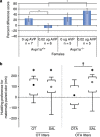Developmental perspectives on oxytocin and vasopressin
- PMID: 24863032
- PMCID: PMC4262889
- DOI: 10.1038/npp.2014.120
Developmental perspectives on oxytocin and vasopressin
Abstract
The related neuropeptides oxytocin and vasopressin are involved in species-typical behavior, including social recognition behavior, maternal behavior, social bonding, communication, and aggression. A wealth of evidence from animal models demonstrates significant modulation of adult social behavior by both of these neuropeptides and their receptors. Over the last decade, there has been a flood of studies in humans also implicating a role for these neuropeptides in human social behavior. Despite popular assumptions that oxytocin is a molecule of social bonding in the infant brain, less mechanistic research emphasis has been placed on the potential role of these neuropeptides in the developmental emergence of the neural substrates of behavior. This review summarizes what is known and assumed about the developmental influence of these neuropeptides and outlines the important unanswered questions and testable hypotheses. There is tremendous translational need to understand the functions of these neuropeptides in mammalian experience-dependent development of the social brain. The activity of oxytocin and vasopressin during development should inform our understanding of individual, sex, and species differences in social behavior later in life.
Figures




References
-
- Aguilar-Valles A, Vaissiere T, Griggs EM, Mikaelsson MA, Takacs IF, Young EJ et al (2013). Methamphetamine-associated memory is regulated by a, writer and an eraser of permissive histone methylation. Biol Psychiatry pii: S0006-3223(13)00855-X. doi:10.1016/j.biopsych.2013.09.014 (e-pub ahead of print). - PMC - PubMed
-
- Albers HE (2012). The regulation of social recognition, social communication and aggression: vasopressin in the social behavior neural network. Horm Behav 61: 283–292. - PubMed
-
- Alberts JR (2007). Huddling by rat pups: ontogeny of individual and group behavior. Dev Psychobiol 49: 22–32 Group huddling behavior responds to central administration of oxytocin on day 10 in neonatal rats. - PubMed
-
- Almazan G, Lefebvre DL, Zingg HH (1989). Ontogeny of hypothalamic vasopressin, oxytocin and somatostatin gene expression. Brain Res Dev Brain Res 45: 69–75. - PubMed
-
- Altstein M, Gainer H (1988). Differential biosynthesis and posttranslational processing of vasopressin and oxytocin in rat brain during embryonic and postnatal development. J Neurosci 8: 3967–3977 This classic paper (among others) demonstrates the earlier emergence of vasopressin relative to oxytocin in rat brain development. - PMC - PubMed
Publication types
MeSH terms
Substances
LinkOut - more resources
Full Text Sources
Other Literature Sources
Medical
Molecular Biology Databases

